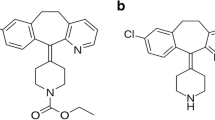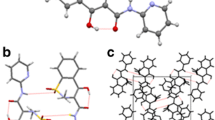Purpose
The aim of the study is to examine the influence of slip planes on the nanoindentation hardness and compaction properties of methyl, ethyl, n-propyl, and n-butyl 4-hydroxybenzoate (parabens).
Methods
Molecular modeling calculations, embodying the attachment energy concept, were performed to predict the slip planes in the crystal lattices, whereas the nanoindentation hardness of the crystals and the tensile strength of directly compressed compacts were measured.
Results
Unlike the other three parabens, methyl paraben has no slip planes in its crystal lattice, and its crystals showed greater nanoindentation hardness, corresponding to lower plasticity, whereas its tablets exhibited substantially lower tensile strength than those of ethyl, propyl, or butyl paraben.
Conclusions
The nanoindentation hardness of the crystals and the tensile strength of directly compressed tablets were each found to correlate directly with the absence or presence of slip planes in the crystal structures of the parabens because slip planes confer greater plasticity. This work presents a molecular insight into the influence of crystal structural features on the tableting performance of molecular crystals in general and of crystalline pharmaceuticals in particular.





Similar content being viewed by others
References
C. Sun D. J. W. Grant (2001) ArticleTitleInfluence of crystal structure on the tableting properties of sulfamerazine polymorphs Pharm. Res. 18 274–280 Occurrence Handle11442264 Occurrence Handle1:CAS:528:DC%2BD3MXltVSksLk%3D Occurrence Handle10.1023/A:1011038526805
E. Shotton J. E. Rees (1966) ArticleTitleThe compaction properties of sodium chloride in the presence of moisture J. Pharm. Pharmacol. Suppl. 18 160–167 Occurrence Handle1:CAS:528:DyaF2sXit1WltA%3D%3D
C. D. Teng M. H. Alkan M. J. Groves (1986) ArticleTitleThe effect of adsorbed water on compaction properties and the dissolution of quinacrine hydrochloride from compacted matrixes of soy protein Drug Dev. Ind. Pharm. 12 2325–2336 Occurrence Handle1:CAS:528:DyaL28Xmtlagt7o%3D
C. Sun D. J. W. Grant (2001) ArticleTitleInfluence of crystal shape on the tableting performance of l-lysine monohydrochloride dihydrate J. Pharm. Sci. 90 569–579 Occurrence Handle11288101 Occurrence Handle1:CAS:528:DC%2BD3MXjt1Ols7c%3D Occurrence Handle10.1002/1520-6017(200105)90:5<569::AID-JPS1013>3.0.CO;2-4
G. Alderborn C. Nyström (1982) ArticleTitleStudies on direct compression of tablets. IV. The effect of particle size on the mechanical strength of tablets Acta Pharm. Suec. 19 381–390 Occurrence Handle7180505 Occurrence Handle1:STN:280:BiyD1Mnlt1E%3D
C. Sun D. J. W. Grant (2001) ArticleTitleEffects of initial particle size on the tableting properties of l-lysine monohydrochloride dihydrate powder Int. J. Pharm. 215 221–228 Occurrence Handle11250107 Occurrence Handle1:CAS:528:DC%2BD3MXhslelurs%3D Occurrence Handle10.1016/S0378-5173(00)00701-8
P. Narayan B. C. Hancock (2003) ArticleTitleThe relationship between the particle properties, mechanical behavior, and surface roughness of some pharmaceutical excipient compacts Mater. Sci. Eng. A355 24–36 Occurrence Handle1:CAS:528:DC%2BD3sXkvVWisLY%3D
E. N. Hiestand (1997) ArticleTitlePrinciples, tenets and notions of tablet bonding and measurements of strength Eur. J. Pharm. Biopharm. 44 229–242 Occurrence Handle1:CAS:528:DyaK1cXis1Wisw%3D%3D Occurrence Handle10.1016/S0939-6411(97)00127-6
P. N. Davies J. M. Newton (1996) Pharmaceutical Powder Compaction Technology Marcel Dekker New York, NY 165–191
W. D. Callister (2000) Materials Science and Engineering: An Introduction Wiley New York, NY
J. C. Osborn, P. York, R. C. Rowe, and R. J. Roberts. Prediction of slip planes in molecular crystals by molecular modeling. In Proceedings from the 14th International Symposium on Industrial Crystallization, Cambridge, UK, Sept. 12–16, pp. 1166–1174 (1999).
M. G. Soni G. A. Burdock S. L. Taylor N. A. Greenberg (2001) ArticleTitleSafety assessment of propyl paraben: a review of the published literature Food Chem. Toxicol. 39 513–532 Occurrence Handle11346481 Occurrence Handle1:CAS:528:DC%2BD3MXjtleqsLo%3D Occurrence Handle10.1016/S0278-6915(00)00162-9
F. Giordano R. Bettini C. Donini A. Gazzaniga M. R. Caira G. Z. Zhang D. J. W. Grant (1999) ArticleTitlePhysical properties of parabens and their mixtures: solubility in water, thermal behavior, and crystal structures J. Pharm. Sci. 88 1210–1216 Occurrence Handle10564071 Occurrence Handle1:CAS:528:DyaK1MXmtlCksrs%3D Occurrence Handle10.1021/js9900452
X. Liao T. S. Wiedmann (2005) ArticleTitleMeasurement of process-dependent material properties of pharmaceutical solids by nanoindentation J. Pharm. Sci. 94 79–92 Occurrence Handle15761932 Occurrence Handle1:CAS:528:DC%2BD2MXjslykuw%3D%3D Occurrence Handle10.1002/jps.20227
H. E. N. Hiestand D. P. Smith (1984) ArticleTitleIndexes of tableting performance Powder Technol. 38 145–159 Occurrence Handle1:CAS:528:DyaL2cXksVentLk%3D Occurrence Handle10.1016/0032-5910(84)80043-1
S. Pedersen H. G. Kristensen (1995) ArticleTitleCompaction behavior of 4-hydroxybenzoic acid and two esters compared to their mechanical properties Eur. J. Pharm. Biopharm. 41 323–328 Occurrence Handle1:CAS:528:DyaK2MXps1Sjtbk%3D
J. M. Newton A. B. Mashadi F. Podczeck (1993) ArticleTitleThe mechanical properties of an homologous series of benzoic acid esters Eur. J. Pharm. Biopharm. 39 153–157 Occurrence Handle1:CAS:528:DyaK2cXmtlyhs74%3D
Acknowledgments
The authors thank the following: Professor Mino R. Caira and Professor Ferdinando Giordano for providing the detailed crystal structures of the four parabens (Reference 12), Dr. Matthew Mullarney, Dr. Bruno Hancock, and Dr. Chetan Pujara for their valuable advice and industrial mentorship, Dr. Timothy S. Wiedmann for advice with the nanoindentation hardness measurements, the National Science Foundation (NSF) Center for Pharmaceutical Processing Research (CPPR) for major financial support, all members of the Industrial Advisory Board of the CPPR for helpful suggestions, the Supercomputing Institute of the University of Minnesota for financially supporting our use of the Visualization—Workstation Laboratory for the molecular modeling studies, the Characterization Facility of the University of Minnesota for use of an atomic force microscope for measurements of nanoindentation hardness of the parabens crystals, and the Graduate Department of Pharmaceutics, University of Minnesota, for partial financial support.
Author information
Authors and Affiliations
Corresponding author
Rights and permissions
About this article
Cite this article
Feng, Y., Grant, D.J.W. Influence of Crystal Structure on the Compaction Properties of n-Alkyl 4-Hydroxybenzoate Esters (Parabens). Pharm Res 23, 1608–1616 (2006). https://doi.org/10.1007/s11095-006-0275-9
Received:
Accepted:
Published:
Issue Date:
DOI: https://doi.org/10.1007/s11095-006-0275-9




